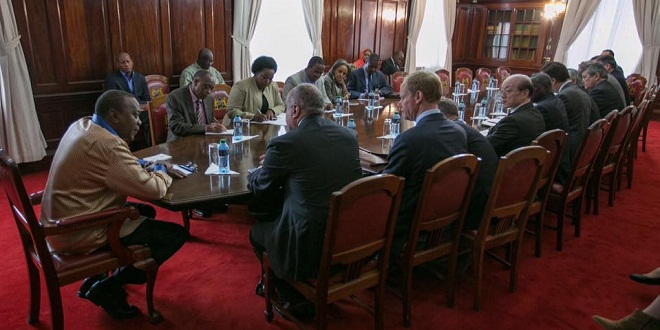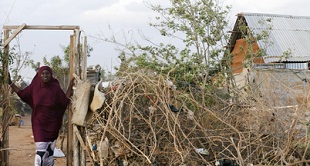
Baidoa, Somalia | AFP | As a teenager, Aden Hussein chose to become a refugee to get an education.
With Somalia in collapse, he left his family for neighbouring Kenya where Dadaab, one of the largest and oldest refugee camps in the world, offered a de-facto city served by the UN and dozens of aid agencies.
“There I had free education,” he told AFP.
Last August, six years after arriving, Hussein, now 21, took advantage of a repatriation package offered to Somali refugees when the Kenyan government said it would close the camp.
Hussein said he was given $400 (355 euros) and promised healthcare, shelter and schooling — the same benefits he enjoyed in Dadaab.
Human rights organisations have protested that refugees are being coerced into returning to a war zone where none of these services are available and, in the end, Hussein only received the cash.
He is bitterly disappointed that he has not been able to finish high-school since his return to Baidoa in southwestern Somalia.
– Casualties of chaos –
In the past 18 months more than 50,000 refugees have left Dadaab for Somalia, a country that has been a byword for “failed state” since civil war felled the government in 1991.
One of the countless casualties of the chaos is the national education system which successive fragile governments have failed to rebuild.
The only schools outside the major cities are Islamic madrases and the ones that are functioning lack properly trained teachers or a standardised curriculum.
Patrick Mbugua, the Somalia Researcher for Amnesty International, who recently returned from a fact-finding mission in Baidoa told AFP that the majority of refugees he spoke to said their children were not in schools.
Those who were, found a school system in shambles.
Of the 29 schools in Baidoa, some are privately-run and follow the Ethiopian, Kenyan, Ugandan or even Qatari curriculums while public schools adhere to a Somali curriculum dating back to the pre-war era and unchanged in more than 20 years.
By contrast, all schools in Dadaab follow the “very modern” Kenyan curriculum.
“[The] education system in Somalia is not fully functional and continues to face challenges,” Julien Navier, a UNHCR Senior External Relations Officer told AFP.
Navier said that returnee parents can opt to keep their children in the academies that follow the Kenyan program.

– No education, no future –
Madina Abdinoor Osman has seven children, five of whom attended school when they lived in Kenya but since returning to Somalia in January none has been in class.
“We need our children to be getting an education,” she said. “A person who learns and a person who does not learn, they are not in the same category.”
A recently “enhanced” repatriation package provides funding to some — but not all — children in each returnee family to go to school. The deal covers education for nine months. After that, parents are on their own.
“I am very much worried,” said Hadija Issak Ali. Two of her five school-aged children are in class now but Ali’s husband is elderly, and she’s not sure how she will continue to pay school fees.
“Our future only depends on our children’s education,” said Ali.
Lack of coordination between Somalia’s central government and federal states is also causing problems.
Sadad Mohamed Nur, a senior education official in South West State’s capital Baidoa, said his department is “ready to support” education but blamed Mogadishu for not releasing funds.
– Vulnerable youth –
“This is a very serious matter,” said Abdullahi Abdirahman Ali the Director of the Rural Education and Agriculture Development Organization (READO), a local charity.
For Ali, the real concern is that uneducated children are easy targets for the Shabaab, an Al Qaeda-linked group that is fighting to overthrow the Mogadishu government and holds sway in much of the countryside.
“Kids at the age of 20 or 18 who have not received any education, then those guys say, ‘Will you join us?’ and they say, ‘Yes.’ It’s easy.”
He also worries that without education, young people might seek their future elsewhere, choosing the dangerous path of migrating to Europe. Somalis are frequently counted among the dead when migrant vessels sink in the Mediterranean Sea.
In 2015, around 21,000 Somalis applied for European citizenship, the majority of them young men.
Hussein’s friends, Ali Hassan Mohamed and Hassan Aden Mohamed, both in their early twenties, also went to school in Dadaab and found their return to Somalia similarly deflating.
Hassan Mohamed said UNHCR workers promised him he would be able to continue his education in Somalia but, “we do not get any school,” he said.
Meanwhile Hussein regularly checks back with the repatriation office to see if any opportunities have arisen for him to go to school, but the promised phone calls never arrive.
He says he would not have left Dadaab if he’d known there was no proper school system in Somalia.
“I came from Dadaab, now I want to go back,” he said.
 The Independent Uganda: You get the Truth we Pay the Price
The Independent Uganda: You get the Truth we Pay the Price




Something serious